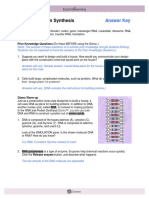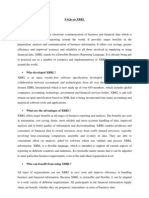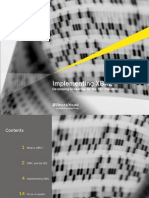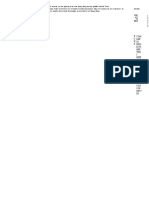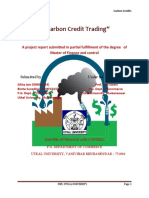Extensible Business Reporting Language (XBRL)
Uploaded by
mmjmmjExtensible Business Reporting Language (XBRL)
Uploaded by
mmjmmj1
eXtensible Business Reporting Language (XBRL)
“eXtensible Business Reporting Language (XBRL)”
An assignment submitted in partial fulfillment of the degree of Master
of Finance and control
Submitted by:-
Sikha Jain (09MFC033)
Nihar Ranjan Kar(09MFC030)
P.G. Department of Commerce
Utkal University, Bhubaneswar
[MFC, UTKAL UNIVERSITY]
2
eXtensible Business Reporting Language (XBRL)
“More transparency is one key to restoring trust, and executives have a fiduciary responsibility to
their stake holders to learn more about XBRL and how this powerful open source royalty free
information standard can help bring transparency and trust back to markets.”
- Liv Watson, a founding member of XBRL International Consortium
Many organizations have been looking to the internet to bring the long-heralded promises of
“better, faster, cheaper” data to organizational decision-making, and specifically to business and
financial reporting. An emerging technology standard, eXtensible Business Reporting Language (XBRL),
promises to web-enable the financial reporting process for both preparers and consumers. Instead of
treating financial information as a block of text, XBRL provides a computer-readable tag to identify each
individual item of data. By attaching identifying tags to individual pieces of data, a business reporting
document becomes “intelligent” data, allowing the exchange of business reporting data by encoding the
information in a meaningful way. Computer applications can use the XBRL data to recognize the
information in an XBRL document - selecting, analyzing, storing, and exchanging it with other computers
and present it in a variety of ways for users. As companies review their business reporting disclosure
controls and procedures and begin to comply with new filing requirements, XBRL is becoming the
chosen tool to help facilitate and restore confidence in business reporting and in turn, to communicate
accurately the value of the company.
History - XBRL's beginning can be traced to the initial efforts of one person, Charles Hoffman, a
certified public accountant from Tacoma, Washington. The American Institute of Certified Public
Accountants (AICPA) was also instrumental in pulling together what eventually became XBRL
International. The Extensible Financial Reporting Markup Language (XFRML) was later renamed as
XBRL. On July 31, 2000, XBRL specifications and the first taxonomy for financial reporting of commercial
and industrial companies were released. The specification has gone through several versions like XBRL
1.0, 2.0, 2.1.
XBRL is a language for the electronic communication of business and financial data which is
revolutionizing business reporting around the world. XBRL stands for eXtensible Business Reporting
Language.
Extensible: means the user can extend the application of a particular business data beyond its original
intended purpose.
Business: means relevant to the type of business transaction.
Reporting: all companies can report their financial statements in a consolidated manner, using the
specified formats.
Language: is a variant of eXtensible Markup Language (XML) that evolved from HTML. HTML is
which prescribes the manner in which, the data can be ‘marked-up’ or ‘tagged’ to make it more
meaningful to human readers as well as to computers based system. eXtensible markup language is an
advanced markup language, which describes the data and says what the data is.
[MFC, UTKAL UNIVERSITY]
3
eXtensible Business Reporting Language (XBRL)
In the above definition, the most useful attribute is ‘Extensibility’.
The concept of ‘extensibility’ works with the ‘tagging concept’. For instance <Asset>1000</Asset>. Here,
<> is a tag. 1000 is the value. Thus the above expression communicates to the computer that there is
something called an ‘Asset’, with a value of 1,000 in it. The information of about at least three
characteristics must be provided to a computer, so that it can understand <Asset> in an accounting
manner. These are:
The asset should have a monetary value (type attribute)
Its balance nature is debit (balance type)
The asset should be a resource available to an entity at a particular point in time (period type)
Table 1 shows how an asset can be defined in the XBRL taxonomy.
Table 1: XBRL Taxonomy
Attributes
Standard Label Element Name Data Type Period Type Balance Type
Fixed Assets Fixed assets Monetary Instant Debit
XBRL Architecture
Taxonomy – it stands for the rules governing classification. This classification may be with respect to
anything like living creatures, organization structure, etc. In this classification the lower level elements
down the hierarchy always have many parents. These classifications often form networks to represent
relationships between elements contained in them.
In the context of XBRL, taxonomy consists of Schema(s), Linkbases and the relationships between them.
[MFC, UTKAL UNIVERSITY]
4
eXtensible Business Reporting Language (XBRL)
Schema – it stores information about taxonomy elements (their names, ids, and other characteristics). It
is created by XML language and the technical extension of schema files has .xsd extension.
Language – technically speaking, every schema document opens with <schema> tag and closes with
</schema> tag. An element is defined inside the schema. However, there might be different elements,
so to distinguish different elements, “namespaces” attribute is used. The main purpose of XBRL schemas
is to provide the computer with information on how it should represent and process accounting terms.
As computers do not have built-in accounting knowledge, so they have to be taught what a particular
concept means and what its characteristics are.
Element – the concept of assets, liabilities, income and expenditure is presented in the form of an
electronic to the computer. To achieve this, elements are defined in schemas and conform to a specific
rule defined, if any.
For example: <element name=”Liabilities” id=”Liabilities” period Type=”instant” balance=”credit”
abstract=”false” substitutionGroup=”item” type=”monetaryItemType”/>
Period Type is of two types:
“Instant” – this is required for the value of assets to be reported at a particular date.
“Duration” – flows such as payments, revenue or profit would have “duration” as period type.
Last, but not least, important a characteristic of an element that has to be defined is its type. In financial
reports, companies include information that is in the form of figures with monetary units(e.g., Rs.100),
numbers (for example number of employees), percents (interest rates), strings (regular text) and others.
Linkbases – it define the relationship between different elements contained in the taxonomy and link
them to specified external resources. Thus, while designing the taxonomy, one needs to label elements
in specified languages to make it readable, referencing elements to the external resources that justify
their existence and that contain an explanation, definition or example of the use of the particular
financial concept, defining relations between elements according to different criteria.
There are five types of linkbases represented in the diagram. Connection to external resources is made
by Label and Refernce Linkbases, while presentation, calculation and definition layers describe element
relationship.
Presentation Linkbase – it is used to represent business data in the appropriate business
reporting format. They represent the hierarchical relationships, while presenting the different
constituents of a business report. The main drawback of hierarchical presentations is that they
fail to represent reports like Statement of Changes in Equity and Movements in Fixed Assets.
Business Reporting Format
[MFC, UTKAL UNIVERSITY]
5
eXtensible Business Reporting Language (XBRL)
Preferred Label Tree Structure
Fixed Assets – Presentation FixedAssets Presentation
Classes of Assets - Presentation ClassesofAssetsPresentation
Acquired Goodwill Net AcquiredGoodwillNet
Calculation Linkbase – this contains the basic validation rules, to sum up or to deduct the
various elements forming part of the business reports. Thus, all monetary elements are first
sorted out and then the lower level elements are summed up to or are deducted from one
another. Finally, the upper level results are arrived.
Example of Calculation Linkbase
Standard Label Weights Tree Structure
Fixed Assets +1 FixedAssets
Net Block +1 NetBlock
Acquired Goodwill, Net +1 AcquiredGoodwillNet
Definition linkbase – it defined the different kind of relationships between the elements. There
are four types of relationships. These are:
1. General-special – it defines a general term with a further extension of its specific nature. For
example, currency is a general term, to which there is more specialized term of INR or USD.
2. Essence-alias – two elements may have a similar meaning. For example, some car manufacturers
may define “Cars” as their main sales component, while others may prefer to show it as “Automobiles”.
To state that these have same meaning, taxonomy designers connect them using “essence-alias” arcrole.
3. Requires-element – the taxonomy designers use it to make the instance creators enter the value of
one element, if they provide the content of another. For instance, an auditor may want to see
disclosures on a particular component of assets, if it appears on the balance sheet. To enable this,
definition linkbase defines “requires-element” relationship between the components of assets.
4. The fourth relation is almost like “essence-alias” relation but is used for tuples. It connects two
tuples that are equivalents in terms of definition (documentation from label linkbase or reference in
reference linkbase), but are diverse from XML.
Reference Linkbase – the financial reports are governed by the statutory presentation
requirements, e.g., IFRS, Company Law, Assets, etc. the elements are referred to the external
regulations/standards by the linkbase. The layer does not contain the full text of the
regulations/standards but points to source documents by refereeing their names and indicating
the relevant paragraphs and clauses. This connection is created using “concept-reference”
arcrole.
Label Linkbase – this linkbase assigns a label to the elements contained in the schema. This may
be assigned with labels for different languages to enable business data to be represented in
different languages. The labels in most of the cases are standardized in order to make it easier
for computers to understand its true meaning. For example, for element name Fixed Assets, the
standard label used is FixedAssets., (Note there is no space between the words). As mentioned
[MFC, UTKAL UNIVERSITY]
6
eXtensible Business Reporting Language (XBRL)
above, elements can be assigned to labels in different languages. To distinguish between
different languages, XBRL uses the XML attribute language. Linkbases use two XML technologies.
The first is known as XLink (XML Linking Languages), which, as its name suggests, allows for the
creation of hyperlinks in XML documents. The second is XPointer (XML Pointing Languages) that
helps to localize specific parts of XML and XBRL documents (e.g., element’s definitions in
schemas).
Taxonomy Extension – taxonomy might require an addition, modification or deletion of an element to
cater to the business reporting requirements. This is achieved by extending the taxonomy, known as
Taxonomy Extension. It requires modifications of linkbases. For this, the creators of extension should be
familiar with the attributes use and priorities as well as the concept of equivalency as there are prescribed
rules to be followed in this regard. Last, but not the least, it should be borne in mind that, extension should
not modify and tamper with any physical file content of the base taxonomy.
DTS (Discoverable Taxonomy Set) – when an XBRL infrastructure contains more than one taxonomy set, it
is termed as Discoverable Taxonomy Set, e.g., an IFRS Taxonomy consists of three schemas plus this is
approached by another entry schema called ITMM (IFRS Taxonomy Modules Manager).
Instance Document – a business report created by XBRL is called the instance document. It refers to the
facts that are defined by the elements in the taxonomy. For instance, the values between tags
(e.g.<Asset>100</Asset>) are found in the instance documents.
Footnote - these are notes that appear on instance documents and provide additional information for some
of the elements. For example, several business reports refer to the statement, “for more information see
Disclosures on Assets”.
Implementation of XBRL through step-by-step project plan
Step 1: Identify a Team – Accountant and XML developer.
Step 2: Assess scope of reporting and determine taxonomy.
Step 3: Comparison and mapping to taxonomies.
Step 4: Extend the taxonomy accordingly.
Step 5: Create an Instance Document to validate calculations.
Step 6: Review and validate Instance Document.
Step 7: Publish on a company website the Instance Documents and Taxonomy and their
Implementation.
Applications
[MFC, UTKAL UNIVERSITY]
7
eXtensible Business Reporting Language (XBRL)
XBRL for Financial Statements – financial statements of all sorts used to exchange financial
information.
XBRL for Taxes – specification for tax returns, which are filed and information exchanged for items
which end up on tax returns.
XBRL for Regulatory Filings – specifications for the large number of filings required by government
and regulatory bodies.
XBRL for Accounting and Business Reports – management and accounting reporting such as all the
reports that are created by your accounting system rendered in XML to make re-use possible.
XBRL for Authoritative Literature – a standard way for describing accounting related authoritative
literature published by the AICPA, FASB, ASB, and others to make using these resources easier, ”drill
downs” into literature from financial possible.
Benefits of XBRL
Eliminates the manual transfer of data, resulting in fewer errors and higher quality data.
Expedities real-time preparation of financial information.
Facilitates customized reporting and quicker analysis of data.
Independent of computer platform and software applications.
The XBRL taxonomy is both free and freely available.
Facilitates continuous auditing.
Time and cost savings arise in collecting, analyzing and validating data.
Risks
Errors in the assignment of tags, for example, the ‘profit before tax’ tag may be assigned to ‘profit
after tax’.
The wrong XBRL taxonomy may be used.
Standard XBRL taxonomies could be customized for the needs of different organizations or
industries.
Conclusion
Research has established that capital markets reward firms that communicate their financial
performance clearly by offering them a lower long-term cost of capital. This clear, concise and correct
information can be provided by XBRL. As a language, it has the potential to become the lingua franca of
business reporting, and early adopters will realize their greatest benefits as it becomes more widely
accepted and used in the financial information supply chain. It is strategically sensible for them to
advocate wider use of XBRL among their business information suppliers and users, and to collaborate
with others to develop and improve published XBRL taxonomies.
[MFC, UTKAL UNIVERSITY]
8
eXtensible Business Reporting Language (XBRL)
[MFC, UTKAL UNIVERSITY]
You might also like
- Introduction To Genetic Analysis (12th Edition)95% (21)Introduction To Genetic Analysis (12th Edition)819 pages
- Understanding Pathophysiology, Fifth Edition - Sue Huether PDF97% (61)Understanding Pathophysiology, Fifth Edition - Sue Huether PDF1,187 pages
- Student Exploration: Natural Selection Gizmo56% (27)Student Exploration: Natural Selection Gizmo4 pages
- 25 Energy Transfer in Living Organisms-Rennel Burgos43% (37)25 Energy Transfer in Living Organisms-Rennel Burgos6 pages
- Genetic Engineering Gizmo Student Exploration Sheet50% (10)Genetic Engineering Gizmo Student Exploration Sheet7 pages
- Encyclopedia of Herbal Medicine - 3rd Edition (DK Publishing) (2016)99% (163)Encyclopedia of Herbal Medicine - 3rd Edition (DK Publishing) (2016)338 pages
- Kami Export - Gene Expression-Translation-S.161755307489% (9)Kami Export - Gene Expression-Translation-S.16175530746 pages
- Student Exploration: Human Evolution - Skull Analysis50% (10)Student Exploration: Human Evolution - Skull Analysis7 pages
- The Immortal Life of Henrietta Lacks by Rebecca Skloot - Excerpt93% (303)The Immortal Life of Henrietta Lacks by Rebecca Skloot - Excerpt31 pages
- XBRL I.E Extensible Business Reporting LanguageNo ratings yetXBRL I.E Extensible Business Reporting Language15 pages
- Extensible Business Reporting Language) : Presented by Biswabhusan Pradhan MFC, Part-INo ratings yetExtensible Business Reporting Language) : Presented by Biswabhusan Pradhan MFC, Part-I7 pages
- Presented by Biswabhusan Pradhan.: Extensible Business Reporting Language)No ratings yetPresented by Biswabhusan Pradhan.: Extensible Business Reporting Language)7 pages
- Study On XBRL Implementation For Financial Reporting.100% (1)Study On XBRL Implementation For Financial Reporting.41 pages
- Finance Assingment On Extensive Business Reporting LanguageNo ratings yetFinance Assingment On Extensive Business Reporting Language27 pages
- Team Action Plan Business Presentation in Black and White Neon Pink Turquoise Bold Gradient StyleNo ratings yetTeam Action Plan Business Presentation in Black and White Neon Pink Turquoise Bold Gradient Style33 pages
- XBRL - A Global Fi Nancial Reporting Standard: ThemeNo ratings yetXBRL - A Global Fi Nancial Reporting Standard: Theme7 pages
- XML Flattened:: The Lessons To Be Learnt From XBRLNo ratings yetXML Flattened:: The Lessons To Be Learnt From XBRL15 pages
- XBRL Extensible Business Reporting LanguageNo ratings yetXBRL Extensible Business Reporting Language30 pages
- Baldwin Et Al 2006 ABS1 XBRL IntermediariesNo ratings yetBaldwin Et Al 2006 ABS1 XBRL Intermediaries21 pages
- Nel & Steenkamp (7.08) - Meditari Vol 16 No 1 2008No ratings yetNel & Steenkamp (7.08) - Meditari Vol 16 No 1 200815 pages
- XBRL RECOMMENDATION 2003 12 31+corrected Errata 2004 04 29No ratings yetXBRL RECOMMENDATION 2003 12 31+corrected Errata 2004 04 29154 pages
- The Guide Workbook For Understanding XBRL 8th Ed.No ratings yetThe Guide Workbook For Understanding XBRL 8th Ed.84 pages
- Hot Topic: XBRL-A New Era in The Delivery of Financial Information?No ratings yetHot Topic: XBRL-A New Era in The Delivery of Financial Information?5 pages
- Financial Accounting - Accounting TheoryNo ratings yetFinancial Accounting - Accounting Theory62 pages
- Extensible Business Reporting Language (XBRL) 2.1No ratings yetExtensible Business Reporting Language (XBRL) 2.1112 pages
- Chapter 09 Test Bank - PDF Courswheo ConnectNo ratings yetChapter 09 Test Bank - PDF Courswheo Connect33 pages
- Changing The Way You Share Financial InformationNo ratings yetChanging The Way You Share Financial Information18 pages
- Kloos et al. - 2014 - XBRL-driven business process improvement A simulation study in the accounting domainNo ratings yetKloos et al. - 2014 - XBRL-driven business process improvement A simulation study in the accounting domain15 pages
- Business Wire White Paper - XBRL Next Steps: What You Need To Know For 2010 and BeyondNo ratings yetBusiness Wire White Paper - XBRL Next Steps: What You Need To Know For 2010 and Beyond9 pages
- H O M E Stan DAR DS Proj Ects MEE Ting S Refe Renc E Libr ARY NEW S & Medi A Abou TUS Stay CON Nect EDNo ratings yetH O M E Stan DAR DS Proj Ects MEE Ting S Refe Renc E Libr ARY NEW S & Medi A Abou TUS Stay CON Nect ED5 pages
- Valuable OSS - Delivering a Return on Your Investment in Operational Support Systems (OSS)From EverandValuable OSS - Delivering a Return on Your Investment in Operational Support Systems (OSS)No ratings yet
- Micronaut in Action: Designing, Developing, and Deploying Resilient, Cloud-Native MicroservicesFrom EverandMicronaut in Action: Designing, Developing, and Deploying Resilient, Cloud-Native MicroservicesNo ratings yet
- XML Programming: The Ultimate Guide to Fast, Easy, and Efficient Learning of XML ProgrammingFrom EverandXML Programming: The Ultimate Guide to Fast, Easy, and Efficient Learning of XML Programming2.5/5 (2)
- Depository Participant Operations: An Enquiry Into Its Mechanics & MismanagementNo ratings yetDepository Participant Operations: An Enquiry Into Its Mechanics & Mismanagement45 pages
- "Role of Technology: Banking The Unbanked": Sam Pitroda, in His Address at The Financial Inclusion SummitNo ratings yet"Role of Technology: Banking The Unbanked": Sam Pitroda, in His Address at The Financial Inclusion Summit3 pages
- PSILOCYBIN MUSHROOMS The Complete Guide To Grow Magic Mushrooms and Safe Use, Discover The Healing Power of Psychedelic Mushrooms by Frank HollandNo ratings yetPSILOCYBIN MUSHROOMS The Complete Guide To Grow Magic Mushrooms and Safe Use, Discover The Healing Power of Psychedelic Mushrooms by Frank Holland62 pages
- Draw 50 Flowers, Trees, and Other Plants The Step-By-Step Way To Draw Orchids, Weeping Willows95% (19)Draw 50 Flowers, Trees, and Other Plants The Step-By-Step Way To Draw Orchids, Weeping Willows278 pages
- Bug 10114837 Rman Deletes The Unapplied Archived Redo LogsNo ratings yetBug 10114837 Rman Deletes The Unapplied Archived Redo Logs4 pages
- MIS604 Requirements Engineering Agile Requirements Analysis & Management Report Students Name Students Number Lecturer's NameNo ratings yetMIS604 Requirements Engineering Agile Requirements Analysis & Management Report Students Name Students Number Lecturer's Name9 pages



